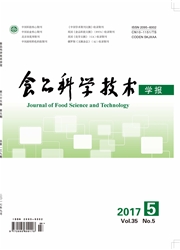

 中文摘要:
中文摘要:
食品安全规制是保证食品质量安全的重要措施.国内相关研究已在购买意愿和企业增效等方面取得了一定成果,但鲜有学者对食品安全规制所引起的生产者福利损失进行探讨.运用水平位移模型考察食品安全规制对猪肉、牛羊肉和禽肉生产企业福利损失的影响.结果显示:供求价格弹性较小、消费需求较大的肉类生产企业所遭受的福利损失较大.其中,猪肉加工企业的福利损失最大,为304.869亿元,占其收入的8.76%;禽肉加工企业次之,为69.142亿元,占其收入的5.45%;而牛羊肉加工企业最小,为68.560亿元,占其收入的9.60%.另外,在食品安全规制影响下,不同类型的肉类加工企业具有不同的单位成本增加额和价格上升压力.每千克猪肉、牛羊肉和禽肉所承受的成本增加额分别为1.07,1.61,0.63元;3类肉产品的提价压力分别为8.76%,9.60%和5.45%.在结论性评述的基础上,提出了有效控制福利损失与执行成本的政策建议.
 英文摘要:
英文摘要:
The food safety regulation has become the important measurement to assure food safety. Although some scholars have studied the related topics both in the consumers' willingness to pay and the ways to increase enterprises' long-term efficiency, it is still lack of relevant studies on the food industries' welfare loss arising from regulation. The purpose of this study was to do in-depth research on welfare los- ses of pork, beef and mutton, and poultry manufacturers using the horizontal displacement model. The results showed that producer losses were higher for meat products with smaller own-price elasticity and more consumption quantities. The losses of pork manufacturer were the largest ( ~304. 869 billion) , which was about 8.76% of its total sales revenue, followed by the losses of poultry manufacturer ( ~ 69. 142 billion) , 5.45% of its total sales revenue. The beef and mutton manufacturer have the lowest losses( ~68. 560 billion) , 9.60% of its total sales revenue. The results also showed that for different meat products, the increase cost per unit product and upward pressure on prices were different. For every kilogram pork, beef and mutton, and poultry, the highest increase cost amount was ¥1.07, ¥ 1.61, and¥0.63, respectively, and the price upward pressure was 8.76% , 9.60% , and 5.45% , respective- ly. Based on the conclusion, this study suggests that it is necessary to effectively control the welfare loss and execution cost.
 同期刊论文项目
同期刊论文项目
 同项目期刊论文
同项目期刊论文
 期刊信息
期刊信息
